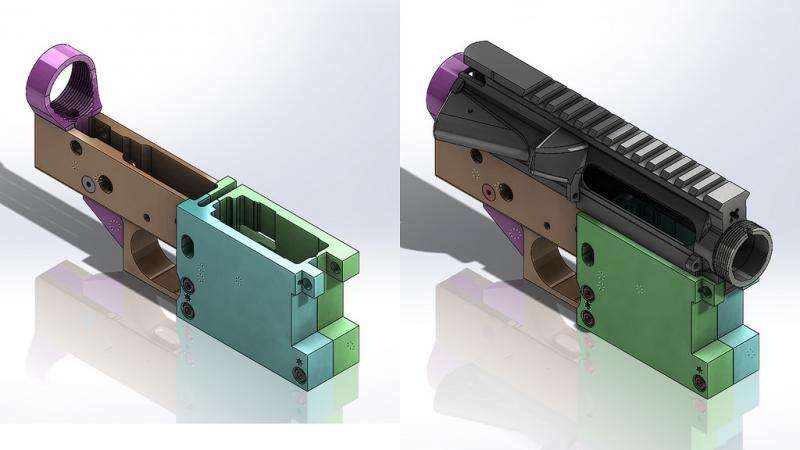3-D printing—a new threat to gun control and security policy?

Following the recent mass shooting in Orlando, and the shootings in Minnesota and Dallas, the sharp political divisions over gun control within the U.S. are once again on display. In June, House Democrats even staged a sit-in to advocate for stronger laws.
There is some evidence that more restrictions can reduce gun violence, but another recent shooting highlighted some limitations of regulation. British Member of Parliament Jo Cox was murdered with a "makeshift gun" despite the United Kingdom's restrictive gun-control laws.
The threat of self-manufactured firearms is not new, but a critical barrier is collapsing. Until recently, most people didn't have the skills to make a weapon as capable as commercially available ones. However, recent developments in the field of additive manufacturing, also known as 3-D printing, have made home manufacturing simpler than ever before. The prospect of more stringent legislation is also fueling interest in at-home production.
Plans for basic handguns that can be created on consumer-grade 3-D printers are readily available online. With more advanced 3-D printers and other at-home technologies such as the Ghost Gunner computer-controlled mill, people can even make more complex weapons, including metal handguns and components for semi-automatic rifles.
These technologies pose challenges not only for gun regulation but also for efforts to protect humanity from more powerful weapons. In the words of Bruce Goodwin, associate director at large for national security policy and research at the Lawrence Livermore National Laboratory, "All by itself, additive manufacturing changes everything, including defense matters."
Policymakers and researchers respond
Government officials have recently begun to react to this emerging threat. The U.S. State Department argued that posting online instructions to make a 3-D-printed single-shot handgun violated federal laws barring exports of military technology. At the local level, the city of Philadelphia outlawed the possession of 3-D-printed guns or their components in 2013.
Those of us in the research community have also been addressing the security implications of additive manufacturing. A 2014 conference of intelligence community and private sector professionals noted that current at-home and small-scale 3-D printing technology can't produce the same quality output as industrial equipment, and doesn't work with as wide a range of plastics, metals and other materials. Nevertheless, participants recommended a number of policies, such as more rigorous intellectual property laws, to counter the evolving threat of unregulated 3-D-printed weapons. These types of policies will become increasingly important as at-home manufacturing of firearms weakens traditional gun control regulations such as those focusing on the buying and selling of weapons.
Expanding the security threat
The danger goes well beyond firearms. Countries seeking to develop nuclear weapons could use additive manufacturing to evade international safeguards against nuclear proliferation. Traditional nuclear weapon control efforts include watching international markets for sales of components needed for manufacturing a nuclear device. Additional measures place restrictions on the types of technology nuclear capable states can export. Additive manufacturing could avoid these efforts by letting countries make the equipment themselves, instead of buying it abroad.
Research into this threat led nonproliferation scholar Grant Christopher to recommend that governments enact export restrictions on certain types of 3-D printers. Nuclear policy experts Matthew Kroenig and Tristan Volpe proposed other approaches to limit additive manufacturing's dangers to nuclear security. One way could be increasing international cooperation to regulate the spread of 3-D printing technology.
Beyond regulating the hardware, governments and industry professionals can also work to more effectively secure the files needed to build components for weapons of mass destruction. Arms control analyst Amy Nelson points out that the risk this kind of data will spread increases as it becomes increasingly digital.
Terrorist groups and other nongovernment forces could also find ways to use 3-D printing to make more destructive weapons. We argue that despite these groups' interest in using weapons of mass destruction, they don't use them regularly because their homemade devices are inherently unreliable. Additive manufacturing could help these groups produce more effective canisters or other delivery mechanisms, or improve the potency of their chemical and biological ingredients. Such developments would make these weapons more attractive and increase the likelihood of their use in a terror attack.
Where to go from here
The worst threats 3-D printing poses to human life and safety are likely some distance in the future. However, the harder policymakers and others work to restrict access to handguns or unconventional weapons, the more attractive 3-D printing becomes to those who want to do harm.
Additive manufacturing holds great promise for improvements across many different areas of people's lives. Scholars and policymakers must work together to ensure we can take advantage of these benefits while guarding against the technology's inherent dangers.
This article was originally published on The Conversation. Read the original article.
![]()


















